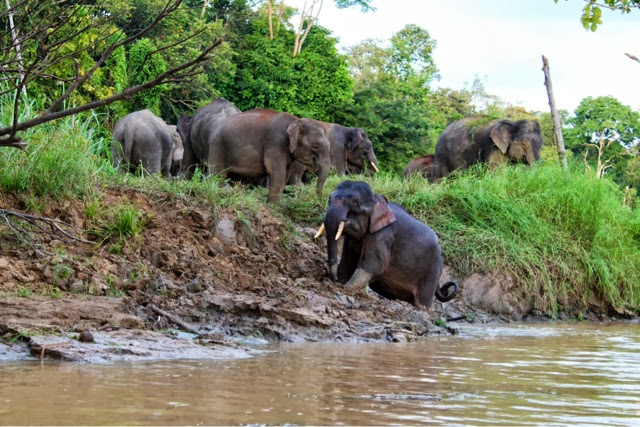So where we left off, we were just about to fly back to Kuala Lumpur to spend a week on Peninsular Malaysia i.e. the mainland. We opted to spend 3 nights in KL exploring the capital followed by 4 nights in Penang, a large island off the Northern Coast renowned for its food and colonial history and architecture. The flight back was fairly uneventful although landing at 12am made it fun and much more expensive to get a transfer to our hostel.
Our hostel, Fernloft, was in Chinatown and this seemed to be the perfect location to explore the central area of KL. We were right next to Central Market so this was our first stop touring the city the next day. We have been to a central market in nearly every major city we have visited in SE Asia so it takes a lot to stand out. KL's was probably the best so far- undercover, air-conditioned, two storeys, excellent selection of souvenirs and hawkers who didn't hassle, chase or try to con you! The stalls were all crazily colourful with jam-packed shelves, often playing loud local music so it was a bit of an attack on your senses....
After getting a few Christmas presents bought to take home with us and having at least an hours wander round the market, our stomachs started to growl. We found the BEST stall selling stuffed parathas which were amazing and cheap.
After another look around the market we headed into Chinatown to check out the open air market there (nowhere near as good with knockoffs and terrible t-shirts being the main trade)
Chinatown is pretty much focused around Petaling Street but it's hard to miss with the huge number of red lanterns everywhere. There were also a number of food stalls selling all types of Chinese delicacies- some of which looked more appetising than others! Rob had to steer clear of the multiple stalls with baking hot ovens filled with roasting chestnuts due to his allergies as we dodged our way through the narrow bustling streets and the army of aggressive hawkers.
Reaching the other end of Chinatown, we were greeted by a random Christmas shop which was totally out of place.
Right next door to this was a Taiwanese Tea Shop called Chatime which did the best smoothies in the world and they were only £1.30! We've since discovered its a chain throughout Asia so we're on the lookout! Rob stopped for a quick haircut at a local barbers (he no longer looks like a vagrant thankfully) and after this we headed back to Central Market for another quick paratha stop (yes, they were that good) before heading back to the hostel.
The next day, we headed out to see one of Kuala Lumpurs few tourist attractions, the Petronas Towers. A really iconic landmark, most people opt to go to the top, however for the £16.00 price tag, we couldn't really justify this. We had read that the first 400 visitors get a free entry, but apparently people queue each day from 6am and we didn't really feel it was worth it. Instead, we satisfied ourselves with going to the bottom to take some photos and simply seeing the building.
We got the LRT to KLCC, our first metro since Hong Kong, and it was really quick and efficient plus it only cost about 20p. KLCC is mall adjacent to Petronas Towers and it is HUGE. Spanning about 8 storeys with every brand name under the sun, there was plenty here to do for the more luxurious traveller, however, even on a tight budget we still managed to spend a whole day here.
There is a seriously amazing food court on the third floor where you can eat super cheap- we both got large burritos (not very authentic) for less than a fiver for both of us. After this we had a wander spying some familiar names from home-
We also took some ridiculous photos, much to the amusement of the other shoppers-
After this, we finally headed outside to see the towers which are very impressive. Standing in this district in KL you could easily be somewhere like New York or Tokyo (apart from the palm trees and tropical humidity!)
After this, we went back into the mall as we had discovered a cinema screening English-language films and we thought we would try our luck to see what was out. We had obviously been film-deprived as we bought tickets to see both Gravity and Prisoners. We thought the gap between the films would give us chance to see the Petronas Towers at night when they are meant to be more spectacular, and grab a quick dinner from one of the other stalls in the food court!
The first film, Gravity, was really good. The only downside was that the screen was freezing cold and a rather generously-sized Malaysian man fell asleep directly behind us after the first five minutes continuing to snore at a ridiculous volume for the proceeding 90 minutes. It was nice to do something normal though rather than sightseeing for one day! After this film we had some black pepper chicken (amazing) and a cupcake (even more amazing) before heading out to see the towers which were definitely more impressive against the night sky.
After our viewing we then returned for the second film. Seeing both films along with buying drinks for the second only cost us £5.00 each- take note British cinemas!!! We took the LRT back to the hostel ready to leave for Penang early the next day. Kuala Lumpur is a lovely city and we had a good time there, but perhaps as this blog has shown, it doesn't offer a huge amount in the way of tourist attractions. Two full days is definitely enough to explore the city and we were glad we could take it at a leisurely pace while enjoying some home comforts!!























































